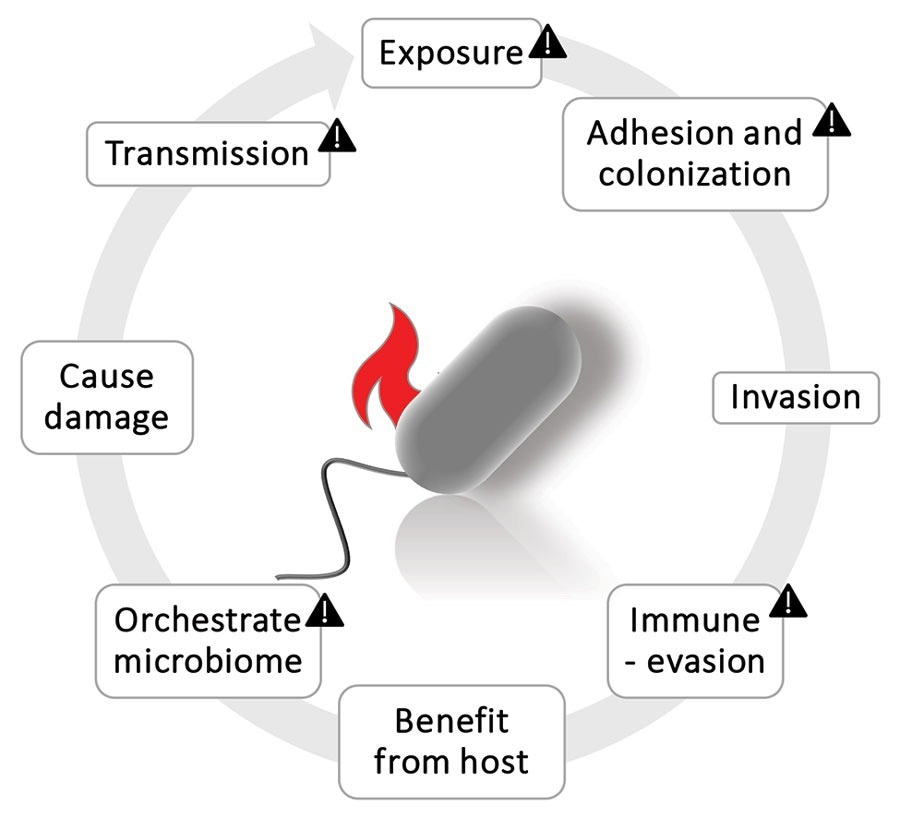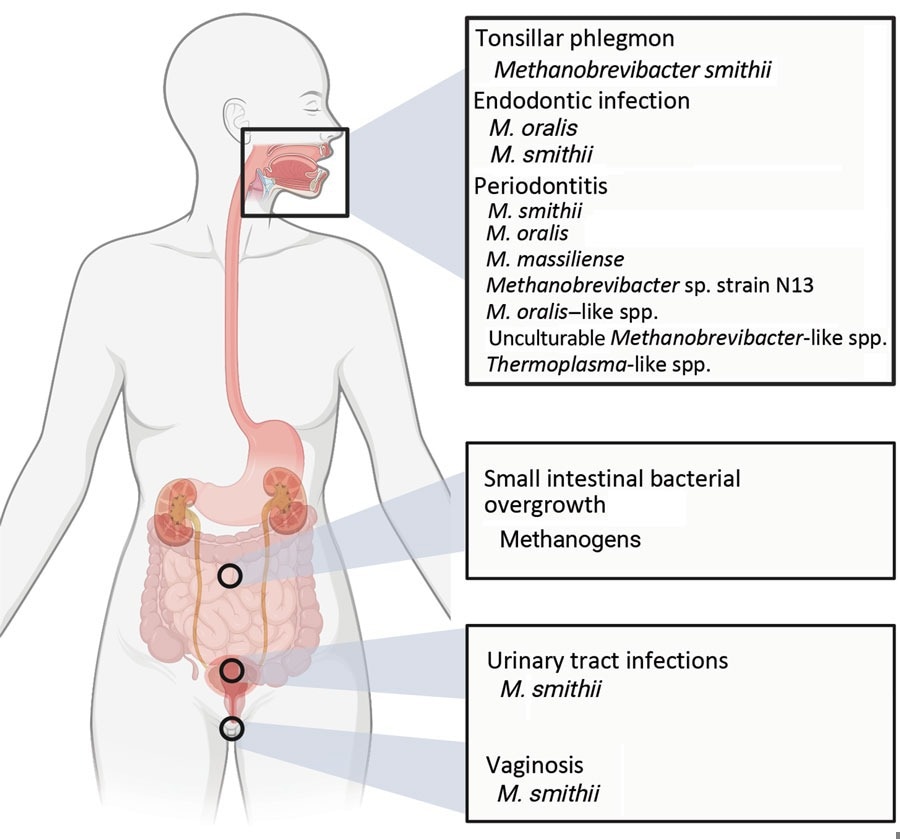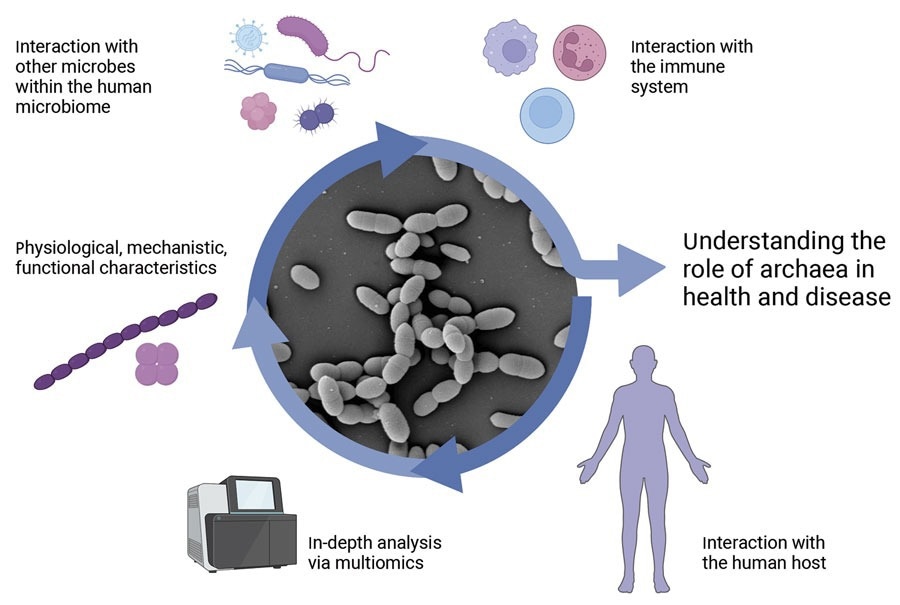Archaea are a group of single-celled microorganisms that represent a separate domain of life, next to bacteria and eukarya. Although they typically reside only in extreme conditions, such as hot springs, recent studies have shown that archaea are essential components of the human microbiome.
A variety of archaeal species have been identified in the human skin, respiratory tract, urogenital tract, and gastrointestinal tract microbiome. Predominant examples include ammonia-oxidizing Nitrososphaeria on the skin, methane-producing (methanogenic) archaea in the urogenital and gastrointestinal tracts and unknown Nanoarchaeota in the respiratory tract. These discoveries indicate a broader ecological role for archaea than previously understood.

Cycle of pathogen actions. Triangles indicate pathogenic potentials for archaea. The other actions still require attention and strategic research. Figure created with BioRender (https://www.biorender.com).
Archaeal pathogenicity
Archaea are commonly considered non-pathogenic despite being known to be associated with various diseases, including periodontitis, endodontic infections, small intestinal bacterial overgrowth, and urogenital tract infections.
Experimental limitations in accurately identifying archaea in disease conditions and gene annotation challenges have been identified as potential reasons for the lack of discovery of archaeal pathogens.
Hypotheses supporting the non-existence of pathogenic archaea suggest that they cannot use the host's organic resources or lack the required virulence factor genes. Additionally, it has been proposed that archaea utilize different cofactors than those found in eukaryotes.
Acquiring a more comprehensive view of the principles of bacterial pathogenic traits is vital to bridging the knowledge gap regarding archaeal pathogenicity.
Biological processes necessary for bacterial pathogenicity include invasion, colonization, damage, and transmission. Archaea also exhibit some of these traits, including host adherence and colonization.
Archaeal immunogenicity is highly species-specific, with Methanobrevibacter spp. showing low immunogenic potential and Methanosphaera spp. showing strong immunogenic potential.
Evidence indicates that archaea can survive for a prolonged period under oxygenated conditions and transmit to other hosts. They can enter and subsequently damage host tissues by interacting with bacterial pathogens in harmful groups.
The robust ability of methanogens to produce methane can lead to the optimization of the entire microbiome for fiber degradation and coping with B12 deficiency. Furthermore, a symbiotic relationship has been found between archaea and bacteria, where archaea utilize hydrogen and other byproducts of bacterial fermentation for methanogenesis.
Moreover, they can produce short-chain fatty acids and vitamin B12, facilitating the growth of archaea and pathogenic bacteria.
These observations suggest that archaea are able to orchestrate the microbiome toward a disease status, even in low numbers.

Infectious diseases in areas of the body in which archaea may have an effect. Figure created with BioRender (https://www.biorender.com).
Archaeal involvement in oral cavity infections
A potential involvement of methanogenic archaea has been observed in periodontitis, a severe gum infection associated with tooth loss, bone loss, and other severe health outcomes.
Methanogenic archaea can account for up to 18% of all microbial species in severe periodontitis. M. oralis, M. smithii, and M. massiliense are some archaeal species identified in periodontitis patients within subgingival plaques and deep periodontal pockets.
Endodontic infection is a microbial infection in a tooth's central part (pulp) that contains nerves, blood vessels, and connective tissues. Methanogenic archaea, especially M. smithii and M. oralis, have been identified in 85% of infected pulp tissues.
Archaeal species, particularly M. smithii, have been found to foster the growth of pathogenic bacteria within Tonsillar phlegmon, which is a retropharyngeal abscess caused by infections in the peritonsillar space and the pharyngeal sphincter.
The methane-producing ability of archaea has been found to contribute to radiologically visible gases in tonsillar phlegmon cases.
Archaeal involvement in gastrointestinal tract infections
Methane levels in human breath serve as a reliable biomarker for the presence of methanogens in the gut. A variation in breath methane level is predictive of bacterial overgrowth in the small intestine.
The symptoms of methanogen-induced small intestinal bacterial overgrowth differ from those caused by hydrogen-producing bacteria. While the former is associated with a reduced incidence of vitamin B12 deficiency, the latter is associated with higher occurrences of symptoms like diarrhea, cholecystectomy, diabetes, and Roux-en-Y gastric bypass surgery.
Such symptom variations might be due to varying sensitivities of archaeal physiology to host factors, including gut anatomy, motility, luminal bile acid concentration, and the capacity to synthesize or salvage vitamin B12 from neighboring microbiota or diet.

Exploration of analytical potentials using archaeal isolates to enhance understanding of the role of archaea in health and disease. Figure created with BioRender (https://www.biorender.com).
Archaeal involvement in urogenital tract infections
The urogenital microbiota contributes to the maintenance of urinary tract homeostasis by influencing immune responses.
The close proximity of the urinary, genital, and gastrointestinal tracts facilitates the transmission of microbes, including archaea, from feces to these regions, which in turn may contribute to the development of various infectious diseases, including urinary tract infections and vaginosis (vaginal microbiota imbalance).
For instance, the archaeal species M. smithii has been found to support the growth of hydrogen-producing enterobacteria responsible for causing urinary tract infections.
M. smithii has also been identified in patients with vaginosis. Archaeal methanogenesis is believed to play a role in maintaining vaginal pH and preserving vaginal microbiota. Further studies are required to ascertain the involvement of M. smithii in vaginosis.